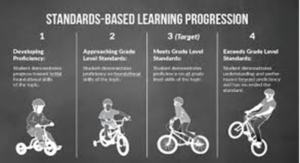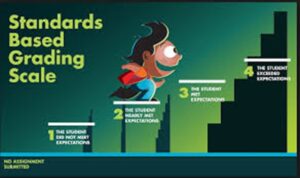Standards-Based Grading
What is Standards-Based Grading?

Standards-based grading is used to measure and report student mastery of the content standards. For each assignment in a unit, teachers determine which standards or substandards are addressed by that activity. As students complete the tasks in that assignment, teachers score their progress on mastering the standards along a 1-4 rubric. These scores are entered into report cards and sent out quarterly for parents and students to see. Additionally, they are tracked in-house as an ongoing record.
The tasks are also compiled into an evidence portfolio so that all stakeholders can compare the student’s work to their scores.
The class summative grade is then based on the average of scores for each standard on the evidence collected to that point.
The goal in standards-based grading is to provide all stakeholders a detailed picture of the student’s learning so that everyone can better track student growth, set learning goals, and truly understand how the student is progressing through the standards.
The Grading Scale
The following grading scale is used to demonstrate student mastery of the standards:
4.0 “I can do this consistently without help and take it further”: The student demonstrates an in-depth understanding of the material by completing advanced applications of the material.
3.0 “I can do this consistently without help”: The student has mastered the complex, targeted knowledge and skills for the class.
2.0 “I can do this with some help”: The student understands the foundational material that supports the targeted learning, but is still working to master the complex material for the class and apply it without scaffolding.
1.0 “I can do this with lots of help”: The student is able to demonstrate some understanding of the foundational material for the class with help from the teacher, but still struggles when working independently.
0.0 “I can not do this yet”: Even with assistance from the teacher, the student shows no understanding of the material.
The intermediate scores of 0.5, 1.5, 2.5, and 3.5 may be used to show that a student has shown partial mastery of the next level of learning.
NC stands for “not complete.” This score is used the student has not completed tasks due to absences or other factors. An NC calculates as a zero in the student’s grade to show the effect of not completing the assessment, but this score will be replaced by the student’s numerical score once the student completes the necessary assessments.

For students in grade/courses where letter grades are traditionally given, and for traditional letter grade report cards, the following conversion scale can be used to convert the standards-based grading scale to the traditional letter scale:
A: 3.75 – 4.00 A-: 3.50 – 3.74 B+: 3.25 – 3.49 B: 3.00 – 3.24 B-: 2.75 – 2.99 C+: 2.50 – 2.74 C: 2.00 – 2.49 C-: 1.75 – 1.99 D+: 1.50 – 1.74 D: 1.25 – 1.49 D-: 1.00 – 1.24 F: 0.00 – 0.99
Standards-Based Reporting Letter (PDF)
